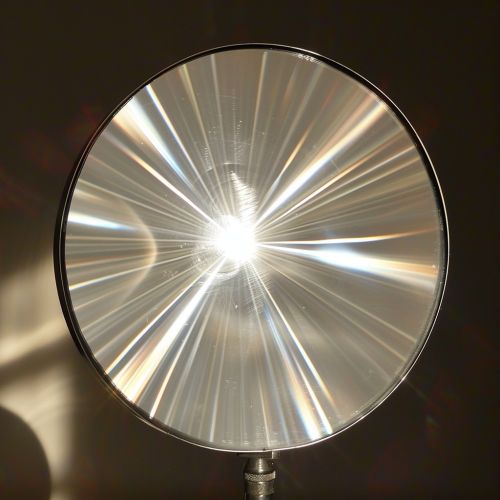Concave mirror: Difference between revisions
(Created page with "== Introduction == A Concave mirror is a type of spherical mirror that is curved inward, resembling a portion of the interior of a sphere. These mirrors reflect light inward to one focal point, hence they are also known as converging mirrors. They have a variety of applications in various fields such as optics, astronomy, and technology. == Physical Properties == Concave mirrors are characterized by their inward curvature. The center of this curvature, known as the...") |
No edit summary |
||
| (One intermediate revision by the same user not shown) | |||
| Line 27: | Line 27: | ||
* [[Spherical mirror]] | * [[Spherical mirror]] | ||
[[Image:Detail-77991.jpg|thumb|center|A concave mirror reflecting light rays towards a single focal point.|class=only_on_mobile]] | |||
[[Image:Detail-77992.jpg|thumb|center|A concave mirror reflecting light rays towards a single focal point.|class=only_on_desktop]] | |||
[[Category:Optics]] | [[Category:Optics]] | ||
[[Category:Physics]] | [[Category:Physics]] | ||
[[Category:Technology]] | [[Category:Technology]] | ||
Latest revision as of 18:37, 8 May 2024
Introduction
A Concave mirror is a type of spherical mirror that is curved inward, resembling a portion of the interior of a sphere. These mirrors reflect light inward to one focal point, hence they are also known as converging mirrors. They have a variety of applications in various fields such as optics, astronomy, and technology.
Physical Properties
Concave mirrors are characterized by their inward curvature. The center of this curvature, known as the center of curvature (C), is not located on the mirror but at a point of space on the side towards which the mirror opens. The mirror's surface intersects the principal axis at the pole (P). The line joining the pole and the center of curvature is known as the principal axis. The midpoint of the line segment joining the pole and the center of curvature is the focal point (F). The distance PF is called the focal length.
Reflection of Light
The way a concave mirror reflects light is governed by a set of rules known as the mirror equation and magnification equation. When parallel light rays incident on the mirror surface, they reflect and converge at the focal point. The nature of the image formed (real or virtual, erect or inverted, magnified or diminished) depends on the position of the object in relation to the mirror.
Applications
Concave mirrors have a wide range of applications due to their ability to focus light.
Optics
In the field of Optics, concave mirrors are used in optical instruments such as telescopes and microscopes to gather and focus light from distant objects.
Astronomy
In Astronomy, large concave mirrors are used in reflecting telescopes to collect more light from distant celestial objects, providing a brighter and more detailed image.
Technology
In technology, concave mirrors are used in devices such as headlights and searchlights to produce a parallel beam of light. They are also used in solar furnaces to focus sunlight into a small area to generate high temperatures.
See Also


